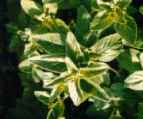Special Feature: Products Sally Recommends
German Food Glossary
introduction | glossary | recipes | cookbooks | sources | crossword
Staples
Pork meat (Schweinefleisch) and Sausage (Wurst)
Pork meat is the most popular source of meat in German cuisine. Cured pork meats and sausages from Germany are renowned all over the world. They come packed in cans, glass jars, or vacuum packed. There are about 1,500 kinds of sausages on the German sausage market. Germans also like to prepare dishes with veal (Kalb), beef (Rind), chicken (Huhn) and venison (Wild).
Herring (Hering)
Herring are, especially in the northern part of Germany, a staple favorite. The small silvery fish are fished in the North and Baltic Seas; they are eaten raw, pickled, smoked and canned.
German cottage cheese (Quark)
Quark is an all-round favorite ingredient in German cuisine. It ccounts for half of the total cheese consumption in Germany. It is very similar to cream cheese but has a mild yogurt flavor, is softer and creamier.
Wines, sparkling wines, brandies (Wein, Sekt, Weinbrand)
Wines, champagnoise-type sparkling wines, (called "Sekt" in erman), and brandies are usually first quality in Germany where stringent production, labeling, and denomination laws regulate the making and distribution of these alcoholic beverages. Riesling, for example, is a legal denomination of a fairly light and fruity wine made from the white Riesling grape variety, the name "Sekt" always indicates a sparkling wine; and "Weinbrand" is the legal German term for brandy distilled from grape products. German wineries are usually grouped in member cooperatives that represent growers who are periodically checked for product quality. With the wine cooperatives system, German wineries can combine traditional wine making skills with the latest technologies in wine making and wine marketing. Famous German wines are produced throughout the wine growing regions of Ahr, Mittelrhein, Mosel-Saar Ruwer, Rheingau, Nahe, Rheinhessen, Pfalz, Franken, Hessische Bergstrasse, Wuerttemberg, Baden, Saale-Unstrut and Sachsen.
Spices
Caraway (Kuemmel)
Small seeds, usually sold dry, that look almost like celery seeds or cumin seeds, which are vital in German cuisine. They are a must in rye bread, in cabbage and in sauerkraut specialties. Their flavor and aroma is totally different from cumin, but they are often mistaken because of the similarity in their name. Cumin in German is "Kreuzkuemmel."
Juniper (Wacholder)
Dark blue juniper berries grow on stout prickly bushes and are easily found in higher wooded areas in Germany. They have a clean flavor that is first slightly bitter, and later almost sweet. Juniper berries often substitute bay leaf in the typical German "bouquet garni." They are also used in marinades of venison to cut the game flavor of the meat, in sauerkraut specialties, and to make a white transparent distilled spirit called "Steinhaeger."
Black and white pepper (Schwarzer und Weisser Pfeffer)
Black and white pepper corns are native to Asia and are an imported product in Germany. They are the small berries of a plant called Piper Nigrum. Both black and white pepper corns come from the same basic plant, and are used abundantly in all German dishes. Black kernels have been picked still red when the pepper berry is not yet fully mature while white kernels are simply the mature pepper product removed of its outer coating. The difference is in appearance and in flavor. Black peppercorns have a stronger flavor; white peppercorns have a milder aroma.
Herbs
Dill (Dille)
It is frequently mistaken for fennel and anise because of its feathery green appearance when fresh. It has a pungent and unique flavor. It is often added to potato salads, to pickled cucumbers, and to seafood dishes like northern shrimp cocktails. Dried dill herb is used during winter months in soups. Dill seeds are frequently used to flavor German bread specialties.
 Marjoram (Majoran)
Marjoram (Majoran)
This green-stemmed plant with round, almost hairy leaves is similar in flavor to oregano but tastes milder. It has a slightly bitter savory flavor and is added frequently to meat dishes and herb butters (Krauterbutter).
Parsley (Petersilie)
Native to Mediterranean regions, it is available fresh, with curly and flat leaves, and dried everywhere in Germany. It is rich in vitamin C, has a pleasant mild flavor, and goes very well with minced garlic and onion mixtures. It is a must in German herb butters.
more on German Cuisine...
introduction |
glossary |
recipes |
cookbooks |
sources |
crossword
Note: This information was accurate when it was published. Please be sure to confirm all rates and details directly with the businesses in question before making your plans.



